Secret Tips on How to Select a Technology Stack for Your Next Project

Key takeaways
- Why does technology stack matter? Learn how the right tech stack can affect the success of your product.
- Explore the top 7 popular tech stacks that are popular among businesses and IT community.
- Forbes 100 and their choice of a tech stack. What is the key to success?
- How to select the most appropriate technology stack and safe money: our advice.
- What do you need to rely on when choosing a tech stack? Find out practical tips shared by our Software Architect.
- Learn how Aimprosoft can help with a choice of tech stack by reading about one of the projects we assisted to develop and the way a correctly chosen stack contributed to the product’s success.
In a previous article on our blog, we wrote about how the discovery phase is important and compared this stage to the architectural plan for a house. Now, continuing the construction topic, we can say that the stack of technology is like the materials that the builder will use while building the house. Therefore, the tech stack choice should be taken seriously because it influences how long the house will stand and whether it can withstand strong winds or natural disasters.
If you look at famous companies like Netflix, Uber, or Amazon, you can see that apart from efficient marketing strategy, modern design, and great CX, a significant part of their success depended on properly chosen, reliable tech stacks. Thus, stay tuned to learn how to choose the right stack for your future product that will help you thrive and establish the firm position in the market.
Why is tech stack influential?
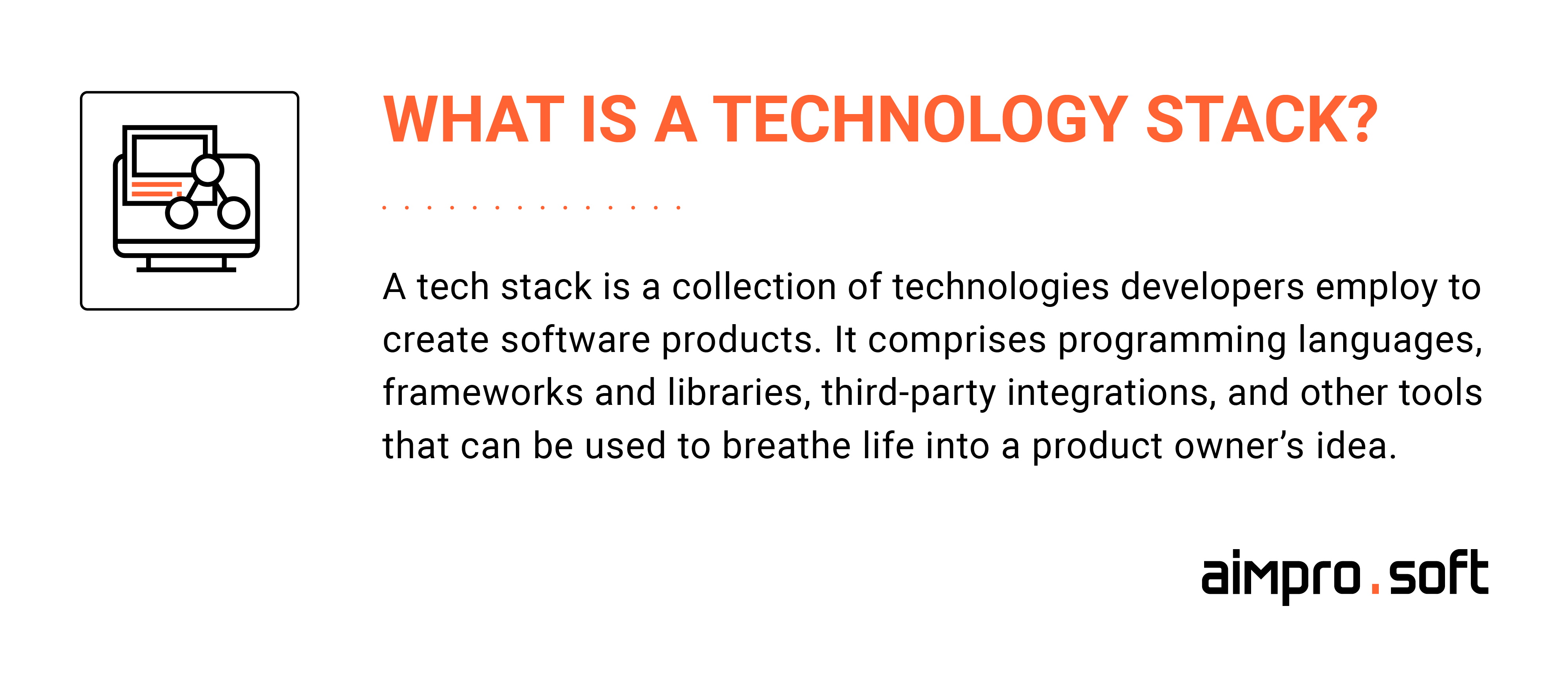
The choice of your tech stack determines the sort of product you can develop, how effectively it can operate, and ultimately determines its viability and prosperity. Let’s try to understand in more detail why selecting the right technology stack is so important. We’ve highlighted several essential reasons for you:
- Choice of technology stack determines the product’s performance, security, and software reliability.
- The technologies chosen as part of a future product’s core tech stack can significantly impact that product’s ability to scale effortlessly.
-
If you eventually change your mind regarding the chosen tools, it may be rather challenging to change the technology stack that you’ve already picked. For example, it is not a simple operation to convert a whole system from Ruby to PHP. Thus, choosing the right technology stack based on your product’s needs and requirements can avoid reworks and significantly save time and, therefore, money. Also, we recommend reading our guide about how to outsource PHP web development.
However, in certain cases, migration from one tech stack to the other is still highly necessary, as the stack chosen at one point in time may be outdated and no longer efficient at the current moment. A bright example of such as scenario is a growing tendency of migrating mobile apps from Objective-C to Swift.
As we can see, all of these factors are significant and demonstrate that a correctly chosen tech stack can bring a significant benefit to your product. That’s why the choice of tech stack should be approached rather carefully, especially if you are not a tech-savvy product owner. Continue reading to understand the structure of a tech stack and how to decide what technology stack is right for your project.
Tech stack structure
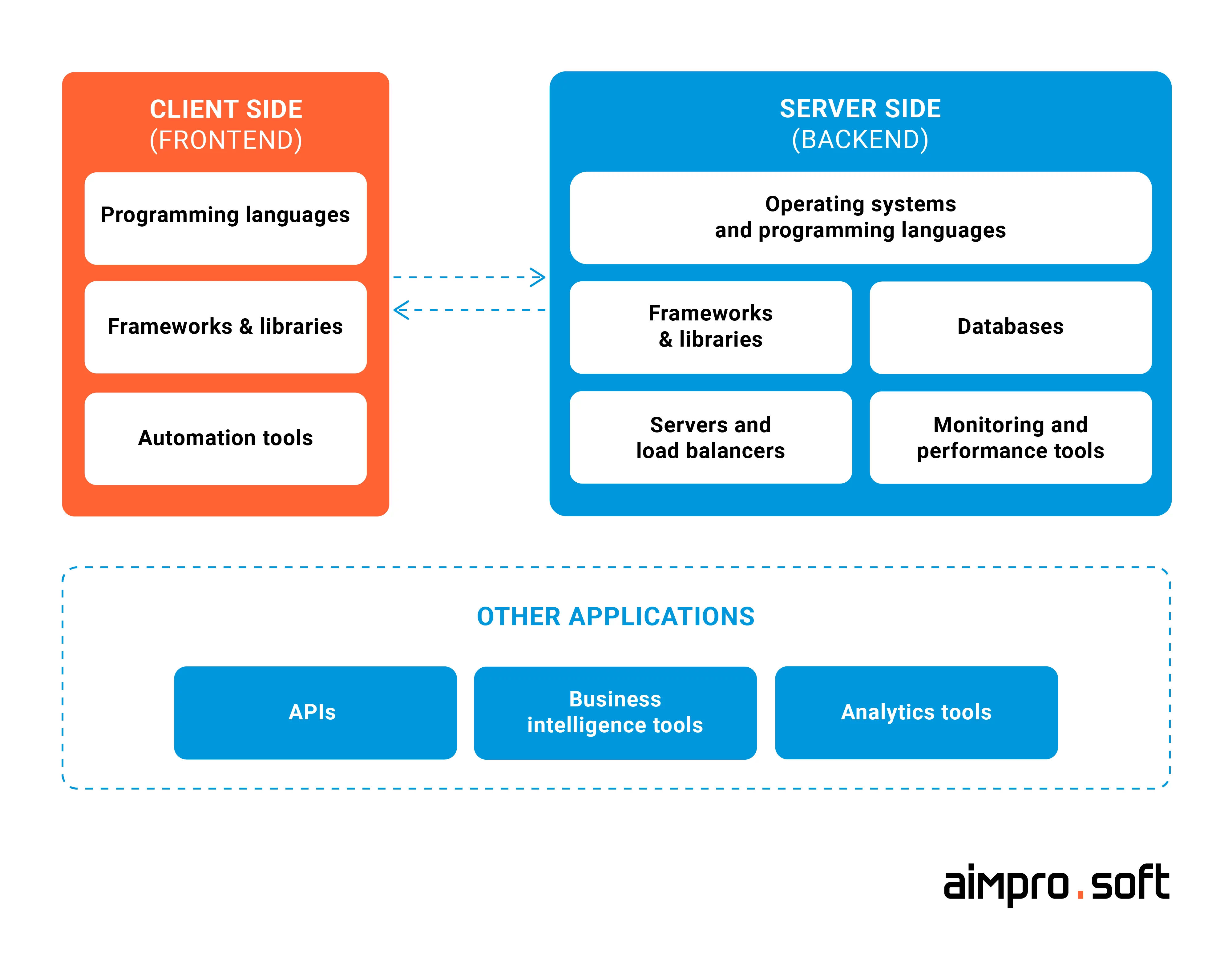
A tech stack is a set of software tools used by software engineers to build mobile, desktop, or web applications. The technological stack consists of two main parts: front-end and back-end; in simple words, client side and server side of the product. Each part consists of programming languages, libraries and frameworks, and other tech tools. Other components that may compose the structure of the tech stack can be middleware, various third-party integrations, such as BI tools, analytics software, payment gateways, and many others, depending on the needs of the product. Let’s look at the main components more precisely.
Front-end technology stack
All users interact with the client-side of the product, called front-end. This is a visible part of your solution. Examples of front-end technologies:
- HTML 一 a hypertext markup language used to create and display electronic documents.
- CSS 一 it is in charge of the web and single page’s format and layout. Font styles, sizes, design, color, and other web page elements are all included.
- JavaScript 一 used to make web pages more interactive. It is a programming language that let’s construct dynamic elements on web pages using libraries and frameworks such as jQuery, React, Angular, and Vue.js.
Back-end technology stack
The back-end stack is an invisible part of the product that comprises technologies that operate in the background to store and handle data, process and respond to the incoming requests, and allow the front-end to accomplish its job. Back-end includes the following technologies:
- Programming languages: C #, Java, PHP, JavaScript, Python, etc.
- Frameworks and libraries: Ruby on Rails, Spring Boot, .NET, Django, etc.
- Databases: Microsoft SQL Server, MongoDB, MySQL, PostgreSQL, Oracle, Neo4j, etc.
- Web servers: Apache, Nginx, Microsoft’s Internet Information Server (IIS), etc.
- Cloud infrastructures: AWS, Microsoft Azure, Google Cloud, Heroku, etc.
Read also the guide to Outsourcing PHP Development
Mobile tech stack
Some programming languages and frameworks are only suitable for building applications for either an Android or iOS platform. Let’s take a deeper look at the technologies used to create mobile apps.
For Android:
- Most common programming languages 一 Java, Kotlin
- Development Tools 一 Android Studio, Android SDK
- Most common UI frameworks 一 Jetpack Compose, Android UI, UI kit
For iOS:
- Most common programming languages 一 Objective-C, Swift
- Development Tools 一 Xcode, AppCode
- Most common UI frameworks 一 UIKit, SwiftUI
Hybrid mobile app development entails producing mobile apps for several platforms at the same time. Such apps are created using a mix of web and native technologies. Developing an app for several platforms may provide your business with certain advantages, such as helping you reach a larger target audience, saving time and money on the development, increasing time-to-market, and others. The most common frameworks for hybrid mobile apps 一 Unity, React Native, Xamarin, and Flutter.
Having explored the basics of the technology stack, let’s examine the most popular tech stack on the market and their main characteristics.
Top 7 popular tech stacks for businesses that aim to succeed
It is no secret that choosing between an innovative technology stack and a time-tested one is recommended to choose the latter. Let’s look at a few popular, well-established tech stacks that are quite popular and credible among the IT community and business owners.
| Name | Technologies included in tech stack | Main characteristics |
|---|---|---|
| LAMP | Linux, Apache HTTP Server, MySQL, and PHP/Perl/Python | LAMP was one of the first open-source software-based stacks to gain widespread popularity. It is widely used among developers since it is adaptable to various web pages and apps. This stack is frequently used to save money on web development. |
| .NET | 60+ frameworks and platforms are in the .NET stack, including CLI languages spread across 13 layers | Developers use .Net technology to construct a functionality and bug-free framework for dynamic and interactive online programs and apps. |
| MERN | MongoDB, React.js, Node.js, Express.js | The stack is designed to make the web app development process more fast and smooth. The stack is also quite efficient for startups since it’s cost-effective, open-source, and very popular among top brands (e.g., UberEats, Walmart app). |
| MEAN | MongoDB, Express.js, AngularJS, and Node.js. | The MEAN stack’s technologies are also free and open-source, with a friendly community where developers may seek assistance. The tech stack works great for startups and small businesses that aim to build dynamic web apps and websites. |
| Ruby on Rails | Works in tandem with JavaScript, HTML, and CSS | Great for startups that plan to develop database-backed web applications. It helps build easy-to-maintain, scalable applications. RoR development framework enables the creation of lightweight applications RoR comes with lots of libraries that make development rather time-efficient. |
| Java* | Spring, Spring Boot, Hibernate, Wildfly, Linux NGINX. | Java stack has huge community support and is considered one of the most reliable technologies. Enterprise solutions, banking applications, mobile apps, and much more can be developed with this stack. |
| React Native | Redux, Redux-Saga, Storybook, Jes, Redux Persist, and other | React Native is a mature and well-established technology for building cross-platform mobile apps. Developers prefer React Native because of its code clarity and simplicity. With the help of this stack, businesses can create mobile apps that provide a great native-like experience, increase time-to-market, and decrease development costs. |
To summarize, we can say that the examined well-established tech stacks have more advantages over emerging ones since numerous top companies already prove their reliability. On top of that, they are supported and constantly updated by a giant community of tech professionals and enthusiasts.
Forbes 100 and their choice of tech stack
Most big companies can declare that the technology stack had a significant role in their success, and it will not be a lie. Let’s glance at some examples of successful digital products and the technology stacks that helped them thrive.
Netflix
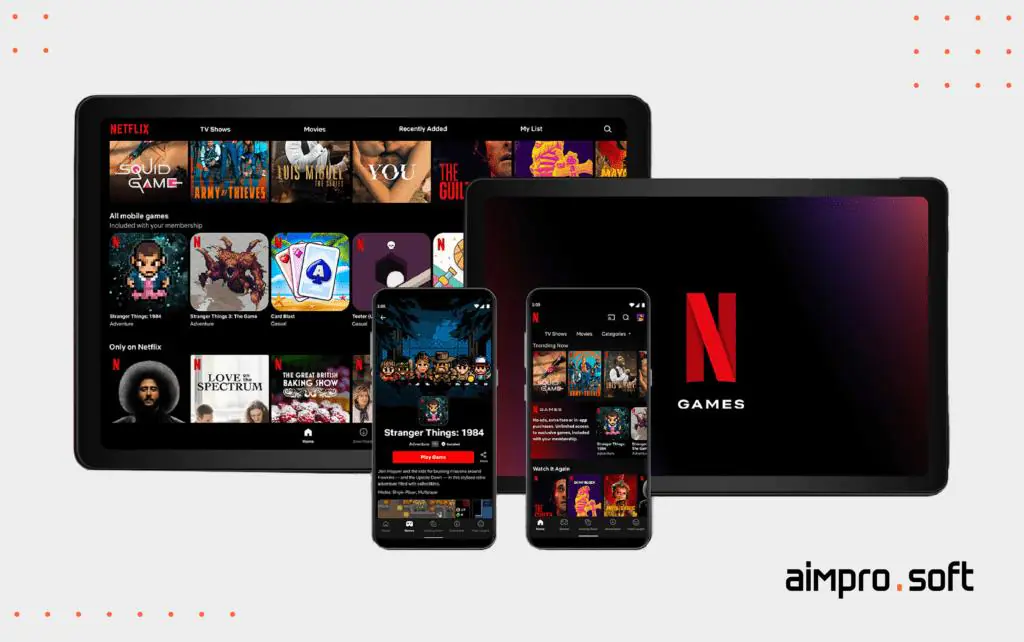
A few words about the product. Netflix is a well-known streaming platform with an extensive library of films and television series. The company has 203.7 million customers globally as of January 2021 and spent $11.8 billion on content production in 2020. Yes, Netflix’s success is truly remarkable. We believe you can create a world-class service, and here are the technological stacks used to build a Netflix-like video streaming app.
Technologies worth mentioning.
- Programming Languages 一 Java, JavaScript, Python, Kotlin, Swift
- Libraries & Frameworks 一 React, WinJS, Node.JS
- Databases & Cloud Services 一 MySQL, Cassandra, Oracle, Amazon EC2, Amazon S3, Atlas-DB
How has the tech stack contributed to the product’s success? Thanks to its technological stack, Netflix is compatible with a wide range of platforms, including browsers, smart TVs, smartphones, and game consoles. React, and JS UI frameworks are responsible for Netflix’s user-friendly interface. Netflix’s usage of Python results in scalability and strong security of the product, while usage of Kotlin grants necessary tooling support.
Slack
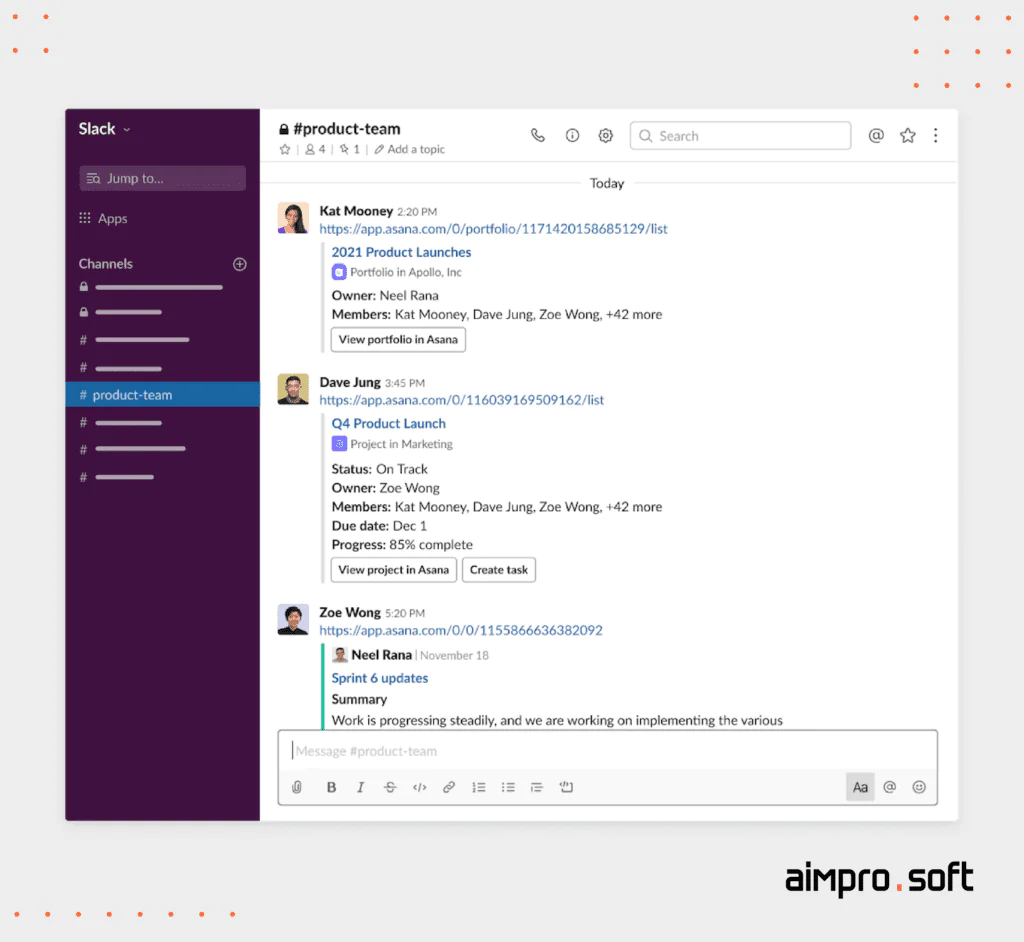
A few words about the product. Since 2013, Slack has become a corporate messenger that has helped millions of people streamline communication and collaboration within companies. At the end of March 2020, Slack reported that the system was being used by a record 12 million people at the same time. Now let us take a deeper look at the technologies that aided in the app’s success.
- Programming Languages 一 PHP, Java, JavaScript, Kotlin
- Libraries & Frameworks 一 Spark, Electron, NodeJS
- Databases & Cloud Services 一 MySQL, Redis, Amazon EC2, Fastly, Amazon CloudFront, Amazon Route 53
How has the tech stack contributed to the product’s success? Thanks to Electron’s cross-platform nature, this desktop program is available for Windows, macOS, and Linux. Slack relies on MySQL technology for high availability, scalability, operability, extensibility, and performance. Since security is one of the top priorities for Slack, constant monitoring of the infrastructure was possible through a centralized logging system enabled by the usage of StreamStash, Elasticsearch, and ElastAlert. In turn, scalability is achieved with the help of Kafka.
Snapchat

A few words about the product. Snapchat is a picture and video-based mobile messaging app. There are over 265 million active Snapchat users throughout the world. In the United States, 75% of Millennials and Generation Z are Snapchat users. This achievement was aided by using the correct technological stack; let’s look deeper at these technologies.
- Programming Languages 一 Java, Swift, Kotlin, Objective-C, JavaScript
- Libraries & Frameworks 一 Cocoa Touch, JQuery, Angular JS, Bootstrap, React
- Databases & Cloud Services 一 NoSQL, MySQL, DocumentDB, MongoDB, Redis
How has the tech stack contributed to the product’s success? Snapchat uses Amazon Web Services (Route 53, CloudFront) for hosting. Google Compute Engine is used to improve automated scalability for a large number of users and to handle temporary data storage. NoSQL is the main database that can manage a high number of structured data while being flexible.
As you can see, the best tech stack can bring long-term success to your product. With the correct tech stack, you can provide your app with scalability, high-level security, and modern functionality and gain a competitive advantage.
Factors to consider when choosing the right technology stack: our tips
After reading the previous part of our article, you’re undoubtedly wondering how to pick a tech stack that will help achieve the success of the popular products listed above? The answer is to know the list of factors that should be considered carefully in order not to choose your tech stack that doesn’t fit the requirements and specifics of your product. Thus, let’s examine all of the important criteria for picking a tech stack.
Type of the product
When choosing the technology stack, it’s important to take into account the type of product you aim to build, namely, its complexity, business objectives you aim to achieve with it, the load it’s supposed to withstand, its size, and potential growth. The more complex the project is (e.g., if you want to make a social media app or an enterprise solution), the more sophisticated combination of tools it will require to implement its functionality.
Your financial capacity
Despite the fact that most of the tools are ready-made or open-source, product owners still need to consider several important aspects that can affect their budget: the developer’s rate that varies depending on the specialization, licensing fees, and product’s maintenance costs. Ready-made tools allow building products faster, however, may be limited in terms of flexibility when it comes to the implementation of custom features. Thus, affordable technologies may have their own risks.
In turn, when it comes to hiring developers, we recommend searching for those specializing in the most well-established and popular technologies since it will be easier to find a replacement for the developer in case of an emergency or necessity in expanding your existing team.
For instance, according to Stack Overflow, JavaScript is the most popular programming language, whereas WebAssembly is the least popular. JavaScript experts will be easier to come by, and you’ll be able to acquire assistance for your application quickly and affordably.
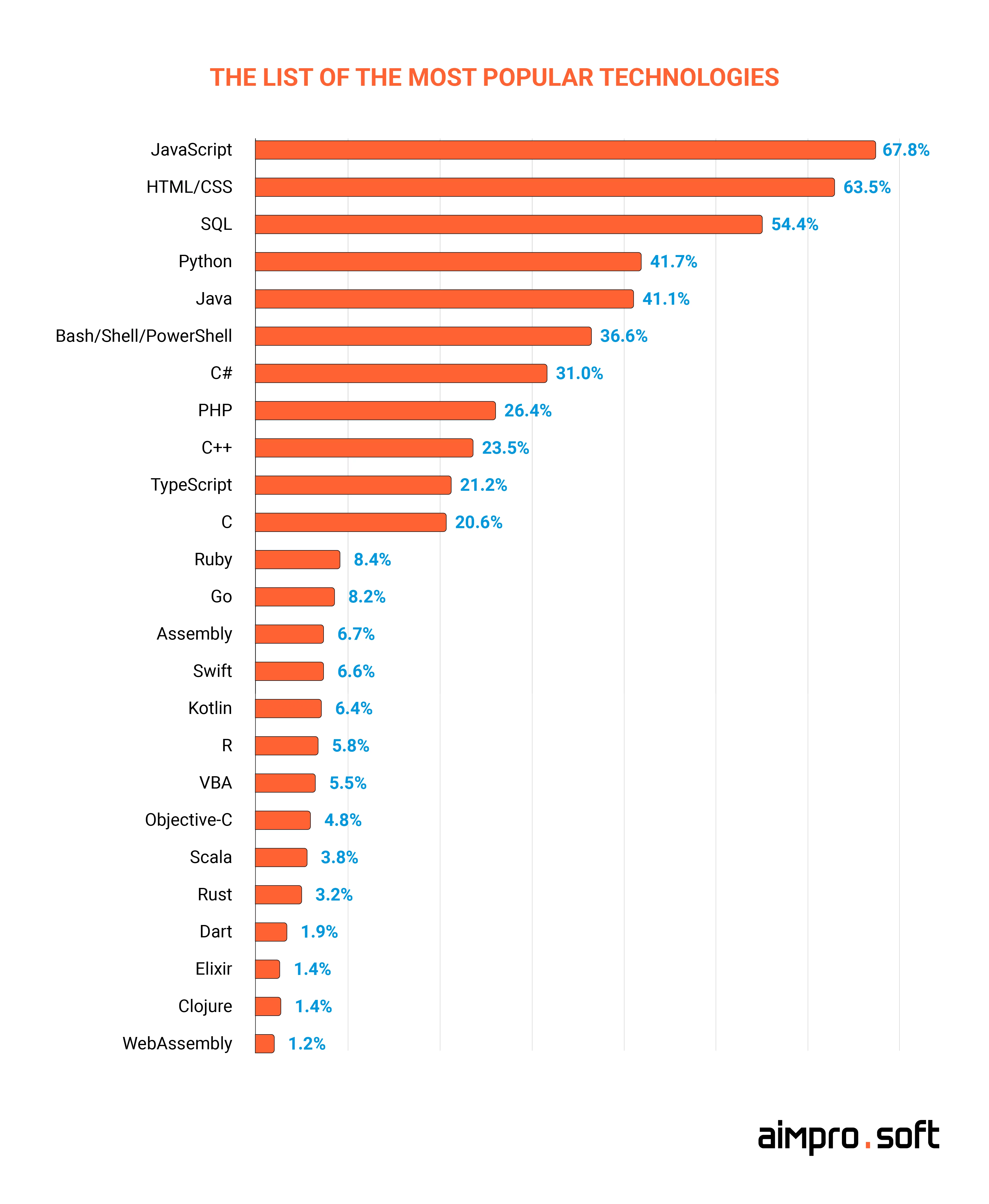
Scalability
It is necessary to consider the growth possibilities and requirements before approving the technology stack. The function of a tech stack in an application’s scalability is to handle the growing volume of users and load and enable the expansion of the functionality. For instance, if you want to create an IoT app, you should rather carefully choose the tech stack since scalability is one of the most important aspects to consider when developing such products.
You should select a technology stack that allows the addition of new compelling features and withstands unpredictable increases in user numbers. Here are some examples of popular scalable tech stacks and separate technologies: MEAN, MERN, RAD, Node.js, React, etc.
Strong security
It’s no secret that security is critical at all times, and it’s also essential to recognize that the risk of cyber attacks grows every year as technological progress grows. For example, if you are planning to build a video chat app, messenger, medical software, or any other solution that contains rather sensitive user information, it is worth protecting yourself with a reliable text stack, excluding all the risks. For example, most popular frameworks like Node.js contain security guidelines.
So, keep in mind that it’s highly crucial to adopt only secure and reliable tools that will help you enable the highest level of security to your solution and constantly update them to avoid open vulnerabilities, like the 0-day vulnerability that was discovered in the popular Java logging library log4j.
Maintenance and team expertise
It’s important to determine whether or not your team will be able to maintain the application once it is deployed. This is the following step after you finish developing your app, and it’s also linked to your tech stack selection. Unless you intend to cooperate with an outsourcing software development company that provides product maintenance services after its implementation, you should take into account your team’s experience when choosing a tech stack. It will be better if you know for sure that your team will be able to use a tech stack successfully and doesn’t require additional training; otherwise, there is no need to consider one.
What determines the cost of the tech stack?
So, now that we’ve covered the fundamentals of choosing a technology stack, it’s time to turn our attention to the topic of money. We understand that startups are frequently on a limited budget. That’s why, in this part, we’ll show you what factors influence the price of a tech stack and provide recommendations on how to save money.
So what are the factors that affect the cost of a tech stack?
-
Popularity and maturity
The price of the technology stack is greatly influenced by it’s maturity and popularity of specific technologies. The old and popular technologies are proven, reliable, and have a large pool of specialists to choose from. You can always find developers specializing in Java but finding Clojure developers will be incredibly difficult. Thus, the fewer specialists who know the new or “unpopular” technology, the more expensive their price tag is.
Therefore, it is always better to turn to the old school. However, we stress that technologies should be both popular and mature since solely the popularity of the project isn’t the only aspect to rely on, while the maturity of certain technologies may sometimes go together with an insufficient pool of specialists to choose from.
-
Licensing
Certain technologies can be very expensive because licensed solutions often have subscriptions, which can include fees for traffic, CPU, and usage in general.
-
Cost of maintenance
Most companies that employ software systems spend a considerable part of their money on the system’s maintenance since the work with the product doesn’t end when it’s released. When choosing a tech stack and hiring developers with the corresponding expertise, mind such expenditures. Product maintenance often includes spending on the solution’s optimization, functionality expansion, bugs identification, fixing, etc. Hence, consider opting for cheaper open-source technologies that can be updated and changed without limitations.
How to save and gain?
We’ve explored the factors that affect the price of a teсk stack. Now let’s find out how you can save money.
-
Find an experienced and proven software vendor
Choose a software vendor that will understand your needs, provide proactive solutions to support your vision, and be a trustworthy partner. The professional software company will also assist you in lowering the charges of your tech stack. They are experts in their field and will undoubtedly advise you on cost-cutting measures.
For instance, when our customers opt for our services with the request to develop document management systems, we always recommend opting for the Alfresco Community Edition solution that has robust OOTB functionality sufficient to cover the essential document management needs and costs approximately $1,400 and $2,800 depending on the type of installation. Such an option is significantly cheaper than the custom implementation of a DMS. And this is just one of the possible scenarios in which an experienced software vendor can help you lower expenditures.
Looking for a tech stack that will meet your business needs perfectly?Please don’t hesitate to contact Aimprosoft so that our specialists can evaluate your requirements and help with the choice.
CONTACT US -
Use ready-made solutions
Such a recommendation is more accurate for startups with limitations in terms of budget and for businesses who want to check their idea with MVP. When it comes to cost, ready-made solutions (e.g., third-party extensions, community-built tools, etc.) can substantially influence cost reduction since they help not to develop a significant part of functionality from scratch, which usually takes lots of time, and as a result money.
-
Cross-platform tools for mobile development
If the goal of your startup is to create a competitive mobile app, but budget restrictions put lots of pressure, you can always save money by employing cross-platform tools instead of native technologies. You may choose the right technology for your application, which will help launch an app across several platforms to save resources in this way. One of the best cross-platform tools on the market in 2022 are React Native, Xamarin, Adobe PhoneGap, Ionic, Flutter, and Sencha.
Feedback vs Discovery phase
Feedback. When we say feedback about choosing a tech stack, we mean doing your own research on the market and basing your choice on users’ feedback. Unfortunately, startups can often choose a technology stack based on users’ feedback or the opinion of other business owners who have launched their products. But it’s easy to forget that there’s no one-size-fits-all solution, and just because one tech stack worked for another project doesn’t mean it’ll work for yours. Without a proper strategy, professional research, tech background, and many other nuances, it’s simply impossible to determine the right stack for your project.
Discovery phase. As we all know, the stack isn’t something that can be repaired with a wave of a magic wand after the product is released. So, when it comes to choosing a tech stack, we highly recommend not skipping one of the most important phases in software development called the discovery stage. This stage aims to avoid fatal errors, reduce possible risks, obtain clear technical descriptions, choose the most appropriate tech stack, and much more. Let’s look closer at those deliverables of this phase that can help when choosing a technology stack.
- Requirements specification 一 with an in-depth analysis of your requirements and their corresponding documentation, it’s easier for a software architect to choose the right tech stack that will help build the project that meets your vision.
- Competitive analysis 一 a profound examination of the direct competitors’ products and the technology stack behind them can help evaluate tools that should be a part of your solution’s stack.
- Feature list 一 the document containing a list of the project’s features. With this document, the team will be able to understand what kind of technology your project needs.
Want to learn more about the discovery stage and its benefits and deliverables for your project?
Now we can understand that shallow research and users’ feedback who don’t know all the subtleties of your project can only damage your project. But a team of professionals will gather all the essential information about your future product and, based on this information, will be able to choose the most acceptable text stack.
Our experience how to choose a tech stack for your project
We suggest taking a closer look at one successful project implemented by the Aimprosoft team.Examine how our team overcame challenges with the outdated tech stack and fulfilled the client’s demands.
Backstory. Since 2013, Aimprosoft has been working on
Genesys PGR, an online platform for the Global Crop Diversity Trust. Genesys is an online database of Plant Genetic Resources for Food and Agriculture (PGRFA) conserved in genebanks throughout the world. It’s a smart and сentralized single entry-point via which users can seamlessly access data from genebanks for various purposes.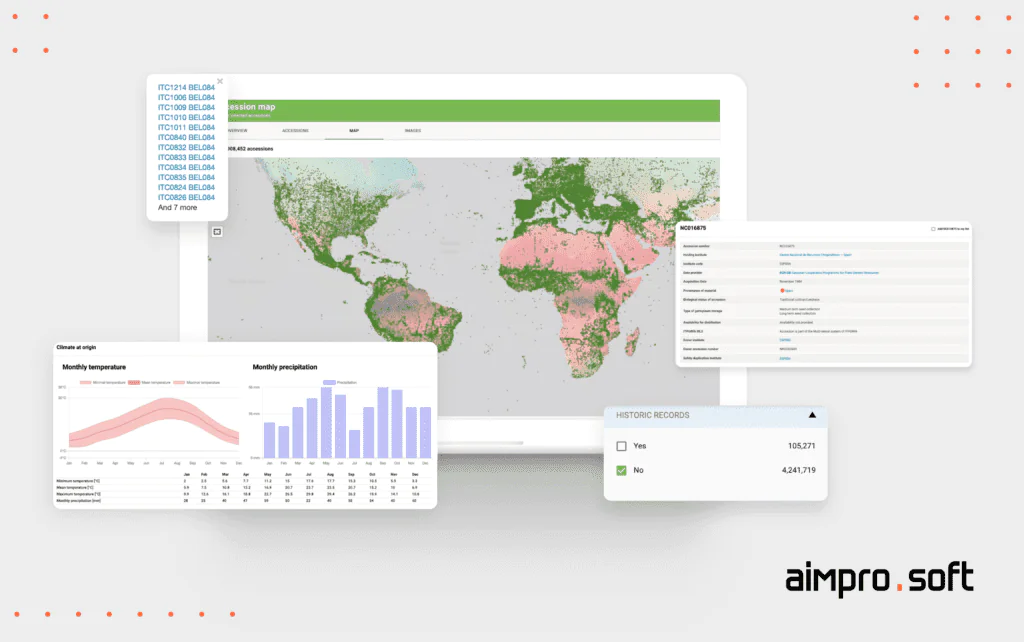
Issues that needed to be resolved. The client approached us with a request to achieve the following objectives:
- allow genebanks to exchange data about their crop collections;
- enable breeders to generate new varieties that are resistant to pests, illnesses, and changing climatic factors using genebank material;
- ensure that the platform’s core is easy to access to genebank data;
- the ecosystem of libraries and frameworks is constantly evolving. To stay relevant, Genesys must be kept up to date.
The selected tech stack.
- Backend technologies 一 Eclipse Jetty, MariaDB, MySQL, Hibernate, Elascticsearch, Hazelcast, Asciidoctor, Amazon S3, Liquibase, QueryDSL, Spring, OAuth 2
- Frontend technologies 一 React, Webpack 4, i18n, Redux, SCSS, d3.js, Material UI
Solution. Our development team used new technologies in the Genesys Catalog project, including React on the frontend and REST APIs on the backend. The objective was to transition to React because the frontend and backend were tightly connected in the old project. React and Angular was considered for the implementation of sever-side rendering. Our team decided to continue further using React after the success of the Genesys catalog project.
In the new version, there is such a feature as visualization with interactive maps. Our developers used Leaflet, a JavaScript library for interactive maps, to create a map-based search for anyone looking to learn more about crops’ provenance, which made the user experience more brilliant. For rapid data contribution, the Genesys platform provides APIs and permits the use of a Java-based Anno upload tool.
Dive deeper into the development process of the Genesys platform and learn more about how the chosen tech stack helped implement the product’s functionality efficiently.
Conclusion
So now we can summarize and say that choosing a tech stack may be a time-consuming and challenging process requiring careful analysis, an in-depth understanding of your product’s objectives, its potential growth, and hands-on experience.
The technological stack you choose is a big decision because it will determine whether the product is able to satisfy end users’ needs and withstand market competition. Moreover, if you are a growing and promising start-up, a reliable tech stack, chosen as the result of the efficiently conducted discovery stage, will also be a significant reason for investors to support your business. Mind that in case the chosen tech stack contains outdated or unpopular technologies, it will be difficult and uncomfortable to maintain the developed product in the long run.
Therefore, to choose a tech stack properly, it is better to hire a team of experts and conduct a discovery phase. So, if you have an idea for a start-up, feel free to contact us, and we’ll help you pick up a tech stack to bring your idea to life.
FAQ
What factors should be considered while choosing a tech stack?
Here’s a list of a few factors you should consider when selecting a tech stack:
- Requirements for the project: size, type, and complexity, etc.
- Availability of IT specialists in the market.
- Project flexibility and scalability.
- Technical specifications, as well as detailed documentation.
- Budget limitations.
Is it possible to migrate from the wrong stack to the right one?
It’s a relatively time-consuming and costly process, but it’s possible. You can swap outdated technology for that which is popular today. In some cases, it is a necessity since existing technologies have reached the end of their life, in other words, the end of their useful lifespan. A good example of such a transition to other technologies is the online platform Genesys, which we have described in our article.
Can a tech stack contain different programming languages and platforms, or should we stick to a single approach?
It’s important to keep technology to a bare minimum, but it’s preferable if something can be done more efficiently using a combination of several programming languages or other tools. Take, for example, Netflix’s tech stack, which combines multiple technologies that only contribute to the product’s success.
What problems may occur after choosing the wrong stack?
If you choose a technology stack that is not right for your project, you may face the following issues:
- Adopting a new stack will take more time, and building the product from the ground up will take even longer.
- If the tech stack was chosen without the scalability aspect in mind, there might be issues with the product being able to scale horizontally and vertically.
- It’s possible that you’ll have a hard time finding developers with experience.
- There might be security issues resulting from the usage of unreliable technologies.




